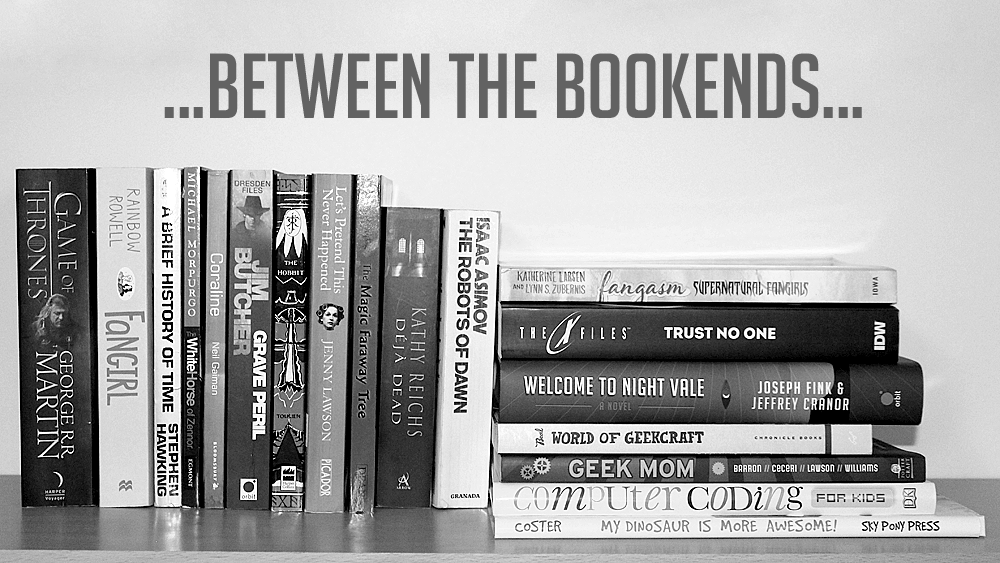
Welcome to the July Between the Bookends column. Before we get to the books which this month have been read by Sophie, Lisa, Patricia, and Sarah, we want to first offer up a statement.
As part of GeekMom’s commitment to working against systemic racism and promoting racially diverse authors, we promise to ensure that these diverse voices are included in EVERY Bookends column from this point forwards. It’s a small step, we know, but we hope it’s one in the right direction and that we can use our voices as book reviewers to make sure those of Black, Indigenous, Asian, and all People of Color are heard in more places.
Please note: This post contains affiliate links.
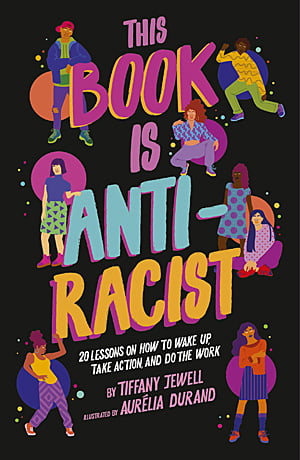
This Book Is Anti-Racist: 20 Lessons on How to Wake Up, Take Action, and Do the Work by Tiffany Jewell
Not the first book Sophie read this month but by far the most important was This Book is Anti-Racist: 20 Lessons on How to Wake Up, Take Action, and Do the Work by Black author Tiffany Jewell. This book is an introduction to systemic racism as it is today, the history that has allowed it to thrive, and also to hands-on activism. It is aimed at teens, helping give them the tools and the language they need to help them stand up to the racist individuals and systems they encounter around them, but it will also be hugely valuable to adults and it is filled with illustrations by Black illustrator Aurélia Durand that are bold, bright, and powerful.
The book is divided into four sections. It begins with “Waking Up”: this introduces broad concepts like social identities, the differences between race and ethnicity, and what exactly racism is (and isn’t). The next section – “Opening the Window” – looks at the history of racism across the west, touching on important stories from the USA, UK, France and elsewhere in easy to understand language. Section three – “Choosing My Path” – introduces ideas for fighting back including disruption, interruption, and solidarity, and the final section – “Holding the Door Open” – looks at privilege, allyship, and building relationships.
Throughout the book are twenty activities to help you learn about yourself and how you fit into or stand outside the dominant culture through things like race, gender, sexuality, and economic class. From the very beginning you are encouraged to grab a notebook and write down thoughts and ideas to help you understand yourself, and also see where you hold privilege and power that you can use to fight systemic racism. In fact, Sophie considered this book to have one of the best explanations of privilege she has ever come across.
Sophie came away from This Book is Anti-Racist feeling not only more informed about racism but also with concrete ideas of things she can do right now to help combat it. She highly recommends this book to anyone trying to “educate themselves” and consistently do more in their lives to help the #BlackLivesMatter movement.

Go Big by Matthew Burton
Sophie’s first book for July was Go Big by Matthew Burton. This really useful book is a guide for kids about to head up to secondary school, and will also be useful for those kids who have recently made the transition. The book is aimed at a British audience and covers the British secondary school experience which can be very different from the US one, although Sophie is sure many sections would translate easily.
Written by a headteacher with lots of school experience, Go Big is divided into four main sections. “On The Way Up” covers some of the biggest fears kids may have about moving to “big school” including getting lost and the myths and rumors that swirl around the move. Sophie agrees that despite hearing about it, she has never known anyone who actually got their head flushed down a toilet.
Section two, “Getting Comfortable” encourages kids to embrace their weirdness, frankly discusses bullying and what to do if it happens to you, handling friendships and fallouts, and it also talks about why uniforms are a necessary evil. “Conquering Challenges” – section three – covers exams, how to handle subjects you struggle with, and what might happen if you find yourself getting into trouble with explanations of terms like detention, isolation, and exclusion. The final section is “Leaping Into the Future” and looks at careers and what to do after final exams.
With a son coming to the end of Year Five, Sophie thinks this book will be invaluable for him and his friends and will be encouraging him to consult it when he has questions and fears about his upcoming move. She highly recommends it to all parents of Year Five and Year Six kids.

Izzy and Frank by Katrina Lehman, Illustrated by Sophie Beer
Izzy and Frank by Katrina Lehman is a cute picture book about a young girl named Izzy and her best friend Frank the seagull. Izzy lives with her family in a lighthouse and spends her days fishing, building sandcastles, battling sea monsters, and exploring the area around her home, always accompanied by Frank and his woolly hat.
One day, however, everything changes. Izzy’s parents move her away from the sea and into a big city where she is expected to go to school, behave politely, and get along with the other children. Izzy doesn’t know how to do any of these things and is heartbroken at leaving her home and, more importantly, Frank, behind. But one day, things change for the better.
This was an adorable short story that reminded Sophie strongly of Hilda – one of her favorite kids’ book/TV series. The story will resonate strongly with any kid who has had to move away from the places and people they love and is written in such a way that young children will be able to follow it easily when it is read aloud, but older kids will enjoy reading it too.
The artwork from Sophie Beer is really beautiful too. The teal and orange color scheme reminded Sophie of Mera: Tidebreaker which she read last year and the images do an amazing job of illustrating how a young child’s imagination can transform their surroundings into places filled with wonder and adventure.
Sophie loved this short book and recommends it to anyone with young children but especially those about to move house and those who live by the sea.
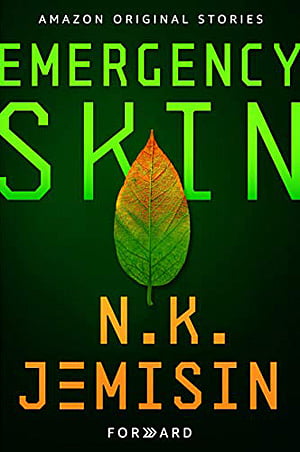
Emergency Skin by N.K. Jemisin
N.K. Jemisin is a name that has been showing up almost daily on Sophie’s book radar over the last few weeks so when she spotted that her short story Emergency Skin was available via Prime Reading (in the UK), she snagged a copy and read it in one short sitting.
Emergency Skin is a science fiction story set many years into the future, long after a small group of humans evacuated the planet to escape the ravages of climate change. Now, they have sent a single individual back to Tellus (their name for Earth) to collect vital cell cultures required on their new home. The being they send back isn’t quite a human anymore – for one they have no skin as this is a privilege afforded only to a few. Instead, they wear a special Composite Suit that holds them together. As this traveler approaches Tellus they are warned about the devastation they will witness. However, upon arrival, they discover that things on Tellus aren’t anything like what they’ve been told and begin to question the history fed to them back home.
Emergency Skin has a very unique narrative style that took a bit of getting used to because the entire book is narrated by an onboard AI that forms part of the Composite Suit talking directly to you/the traveler. The AI withholds certain pieces of information and – because it is formed from the voices of the ruling class back home – explains everything with a biased viewpoint. As you/the traveler learn more about Earth you begin to piece together a very different version of events.
Sophie loved this short story and how it presented such a strong social justice story in such an interesting way. Even though the big reveal is arguably over-simplified, the message it conveys remains powerful. Emergency Skin will certainly appeal to readers who despise the 1% vs 99% structure of society today and Sophie is certain she will be reading more from N.K. Jemisin in the future.

The Con Artist: A Novel by Fred Van Lente
Lisa picked up The Con Artist: A Novel by Fred Van Lente in March, intending to read it right away, but like many others worldwide, she became occupied with other responsibilities that took her away from the simple enjoyment of sitting down with a book. The Con Artist was the ideal book to get back into; a quick, fun, sarcastic, smart read featuring a solid mystery wrapped in pop culture references.
Written by a real comic book writer, the protagonist is a fictional comic book artist, Mike Mason, who has been living a nomadic life of convention hopping ever since breaking up with his wife. He almost skips the big one, San Diego Comic-Con to avoid seeing her, but the first night he is there, a creative rival, partly responsible for the ending of his relationship, is murdered. Mason is a suspect since he got into a very public confrontation with the victim earlier that evening. Mason spends the remainder of the Comic-Con and book juggling his convention obligations with his own personal investigation (with the help of his stoner artist friend Dirtbag) to clear his name and find the real killer.
One of the extra bonuses of this book is Mason’s own illustrations, created by artist Tom Fowler, that actually help a little in solving this murder. This is a fun enough story for people who have no interest in the fandom life but want to know what happens, but those familiar with the comic convention scene (not just SDCC), will love the overabundance of inside jokes. Mason even refers to a pair of detectives as “Sam and Twitch.”
San Diego Comic-Con may not be happening in 2020, but The Con Artist is a fun way to visit it and enjoy a murder mystery in the process.
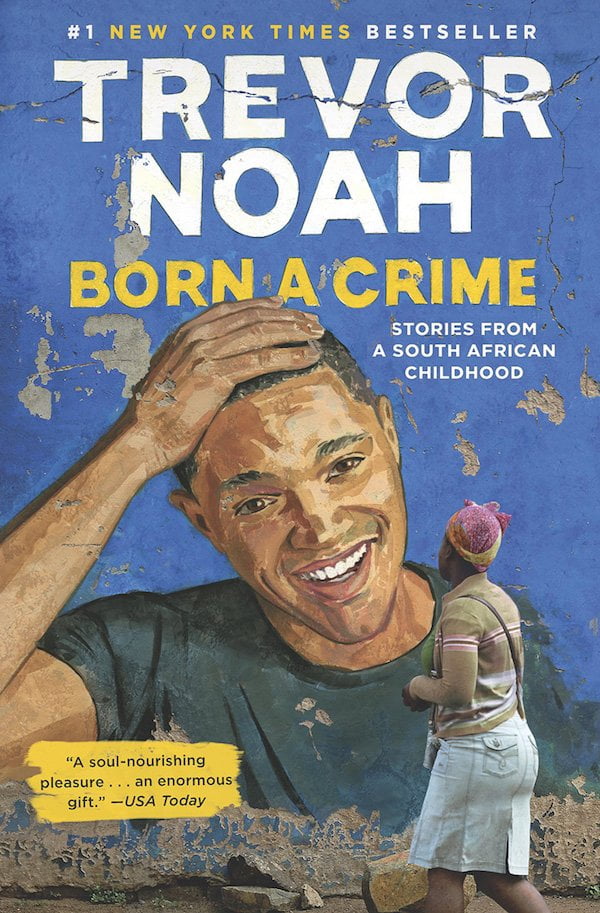
Born a Crime by Trevor Noah
The events these past few weeks in the United States, starting with the murder of George Floyd, has prompted many questions in GeekMom Patricia’s family. They asked themselves, “How do we do things better?” regarding becoming more aware of systemic racism. One of the ways is to try to gain perspectives from People of Color. Patricia’s family, she, her husband, and her 17- and 15-year-old sons, started a summer “Black Lives Matter Book Club,” and chose four books to read and discuss at dinner. Those four books are White Fragility: Why It’s So Hard for White People to Talk About Racism by Robin DiAngelo, Algorithms of Oppression: How Search Engines Reinforce Racism by Safiya Noble, The Color of Law: A Forgotten History of How Our Government Segregated America by Richard Rothstein, and Born a Crime: Stories from a South African Childhood by Trevor Noah.
But Patricia wants to focus on Born a Crime, by The Daily Show host Trevor Noah, for her fellow Geeky Moms. She says, “If readers want to choose one book to learn more about racism, this is it.” She highly recommends listening to the audio book that’s narrated by Mr. Noah himself, since he speaks all the languages fluently and performs in unique voices to portray his mother, grandmother, and himself as a child.
For those who might not be familiar with the talk show host, Trevor Noah is South African; the early part of his childhood was during the country’s apartheid era. Mr. Noah’s stories are poignant and interlaced with humor. He talks about his parents, a mixed race couple whose very existence as a couple was illegal until 1991, his friends while growing up, and his schooling in Johannesburg. He provides a very clear look into what apartheid was really like — not what Patricia learned as an American growing up in the 1980s.
In her youth, Patricia remembers hearing about apartheid on the news. She was not taught much about it in school, and the American news reports were less opinionated. She only remembers that South Africa was a country that legalized racism. But after listening to this book, she is absolutely floored that there was a nation on this earth in the 20th century whose government still considered People of Color “lesser humans.” She’s definitely glad the government repealed the policies…it occurred literally the week she graduated from high school! Listening to Born a Crime, she laughed out loud from some of the funny stories, and more than once had tears in her eyes hearing about his difficult childhood circumstances.
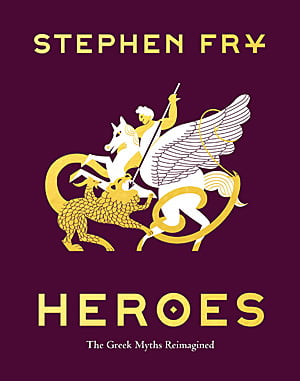
Heroes by Stephen Fry
GeekMom Sarah emerges this week from Ancient Greece. After having consumed the first in Stephen Fry’s Greek trilogy, Mythos, she turned to Heroes. Sitting on the beaches of Maine she read about Jason and the Argonauts and watching her children battle their way across the backyard she read about the Labors of Heracles.
In Mythos, Stephen Fry presented us with renditions of the origin stories of titans, gods, and giants. In Heroes, we find out more about the mortals that had begun to dominate the earth. At the end of the book, we are left with the overwhelming sense that no good deed goes unpunished, but also that we are a lot more like Ancient Greece than we might think. In our idolization of the strong, the rich, the fortunate we are much like the Grecians that we learn about.
GeekMom Sarah read this book side by side with The Rock That is Higher: Story as Truth by Madeleine L’Engle, and both books serve to emphasize that we can learn a lot about ourselves and the world we live in from the stories we tell and the myths we perpetuate. Through his retelling of ancient tales and through her exploration of meaning following a car accident, both Fry and L’Engle show us that myth is important. It gives us a sandbox to play in, to explore thought and concept, to seek truth, and to dispel fiction.
Both Mythos and Heroes are an accessible introduction to the Greek pantheon and the mythology that grew from there. Some of it is a bit gory, some of it lusty, all of it an insight into base humanity. Fry’s humor weaves its way throughout the tales, and you learn to hold loosely your ideas of fact and fiction in the stories that you are reading. A good lesson for our times Sarah feels.
GeekMom received a copy of some books included here for review purposes.




Assignments are daunting task for students for which they look for best academic writers, who can help them to meet tough requirements. Team professional writers are ready to help essaysnassignments.co.uk